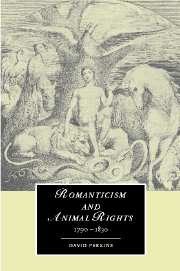Book contents
- Frontmatter
- Contents
- Preface
- Acknowledgments
- 1 In the beginning of animal rights
- 2 Grounds of argument
- 3 Keeping pets: William Cowper and his hares
- 4 Barbarian pleasures: against hunting
- 5 Savage amusements of the poor: John Clare's badger sonnets
- 6 Work animals, slaves, servants: Coleridge's young ass
- 7 The slaughterhouse and the kitchen: Charles Lamb's “Dissertation upon Roast Pig”
- 8 Caged birds and wild
- Notes
- Bibliographical essay
- Index
- CAMBRIDGE STUDIES IN ROMANTICISM
6 - Work animals, slaves, servants: Coleridge's young ass
Published online by Cambridge University Press: 22 September 2009
- Frontmatter
- Contents
- Preface
- Acknowledgments
- 1 In the beginning of animal rights
- 2 Grounds of argument
- 3 Keeping pets: William Cowper and his hares
- 4 Barbarian pleasures: against hunting
- 5 Savage amusements of the poor: John Clare's badger sonnets
- 6 Work animals, slaves, servants: Coleridge's young ass
- 7 The slaughterhouse and the kitchen: Charles Lamb's “Dissertation upon Roast Pig”
- 8 Caged birds and wild
- Notes
- Bibliographical essay
- Index
- CAMBRIDGE STUDIES IN ROMANTICISM
Summary
To this point my theme has been the controversies around hunting, cockfighting, baiting, and similar amusements. In the view of their critics, such things could be dispensed with. A better world would go on without them. Moreover, animal sympathizers were usually not engaged in these, not complicit. I come now to exploitations of animals for work and for food. These involved almost everyone and could not be abolished. Economic life in 1800 was still enormously dependent on animals. They were the cars and trucks, transporting people and goods; the tractors, laboring in the fields; the engines turning wheels that powered machines. And, of course, animals provided or were themselves food, and processes of raising, transporting to market, fattening, and slaughtering animals might evoke compassion. Riders, passengers, mule drivers, hauliers, carters, coachmen, and agricultural laborers, among many others, used work animals – at least two thirds of the population. Households, even urban ones, kept their own poultry and sometimes a pig or cow. With work and food animals, the literature of animal rights could criticize only abuses, unnecessary cruelties, not the thing itself.
Bit, spur, whip, bridle, harness, yoke, and goad now serve most people only as metaphors, but in real life, so to speak, they compel because they constrain or hurt. They hurt more in 1800 than they do now, for designs have improved. Moreover, the treatment of work animals two hundred years ago was probably harsher than it now usually is.
- Type
- Chapter
- Information
- Romanticism and Animal Rights , pp. 104 - 115Publisher: Cambridge University PressPrint publication year: 2003

